Abstract
This study presents a systematic analysis of the optical-physical properties of low clouds and their vertical interaction mechanisms with aerosols over three African sub-regions (A: North African Desert; B: Congo Basin; C: Southeastern Plateau and Coastal Zone) using CALIPSO satellite vertical observations taken between 2006 and 2021. The results revealed distinct spatiotemporal variations: For example, the low-cloud aerosol optical depth (AOD) in Region A peaked during December–February, while Regions B and C exhibited higher values from June to November, with elevated dry-season and daytime levels. A positive correlation emerged between low-cloud AOD and its fractional contribution. Regional contrasts in low-cloud vertical structure were evident, with Region C showing the highest seasonal mean cloud base/top heights and Region A the lowest. The depolarisation ratio of low clouds was higher in desert areas (Region A) but lower in rainforest regions (Region B), while the SRlc (Low-cloud spectral reflectance ratio) was maximised in the Congo Basin (Region B), with wet-season and daytime enhancements. The near-surface aerosol AOD in Regions A and B was positively correlated with low-cloud AOD proportion (PAODlc). Across all regions, the near-surface aerosol layer top height showed positive correlations with the low-cloud base height and vertical extent, while the height of the bottom of the near-surface aerosol layer was positively aligned with the low-cloud base height. For Region C, there were negative correlations between near-surface aerosol layer heights and PAODlc, whereas the springtime aerosol parameters in Region A exhibited positive PAODlc correlations. These findings advance the current understanding of aerosol sources and ecosystem impacts, and provide critical insights for refining aerosol and low-cloud parameterisations in climate models.
1. Introduction
Clouds and aerosols are important components of Earth’s climate system, and profoundly influence atmospheric dynamics through their complex interactions [1,2,3,4,5]. These elements regulate global energy budgets, precipitation patterns, and climate change trajectories [6,7,8,9,10]. Aerosols are directly scattered and absorb solar radiation while indirectly modulating cloud optical properties and longevity, thereby altering radiative forcing [11,12,13,14,15]. During the process of cloud droplet nucleation and growth, aerosols act as key mediators, potentially reshaping precipitation mechanisms and spatial distributions, with cascading socioeconomic implications for agricultural practices, water resource management, and disaster mitigation. Low clouds (with a cloud base height of <2.5 km) are dominant contributors to surface-atmosphere radiative exchanges, and serve as critical regulators of regional-to-global climate variability. Subtle alterations in low-cloud characteristics can trigger significant feedback in climate models [16,17,18]. Notably, regional factors such as surface elevation and landform heterogeneity may further modulate these processes by influencing aerosol transport and cloud microphysics [19,20], though their specific roles in African low-cloud systems require further exploration. Consequently, elucidation of the vertical distributions and interactions between aerosols and low clouds has emerged as a scientific priority for understanding atmospheric processes, climate feedback mechanisms, and evidence-based environmental policymaking. Nevertheless, substantial knowledge gaps persist regarding physicochemical properties, vertical structures, and interaction mechanisms, particularly due to regional variability and system complexity [21,22,23].
The CALIPSO (Cloud-Aerosol Lidar and Infrared Pathfinder Satellite Observations) satellite has unique advantages in regard to comprehensively characterising the optical properties of aerosols and clouds [24,25]. Through the use of Cloud-Aerosol Lidar (CALIOP), this satellite actively emits laser pulses into the atmosphere and detects backscattered signals, enabling high-precision vertical profiling of aerosols and clouds. Unlike traditional passive remote sensing systems that are constrained by solar illumination, CALIPSO can achieve continuous day–night observations, offering enhanced vertical distribution data [26,27]. These observations support investigations of aerosol–cloud interactions and advance climate model parameterisations.
The African continent, which is characterised by its unique geographical and climatic heterogeneity, involves diverse surface types, including the Sahara Desert, Sahel semi-arid zone, West African rainforests, Congo Basin, East African Plateau, and southern Africa [28]. These regions demonstrate pronounced spatial variability in terms of climate, ecosystems, and anthropogenic activities, leading to distinct heterogeneity in aerosol–cloud properties. The Sahara Desert has emerged as a global source of dust aerosols, and significantly influences regional-to-global aerosol distributions and climate dynamics, while biogenic aerosols in the West African rainforests and Congo Basin are strongly correlated with vegetation activity [29,30]. Based on MODIS sensor data from Terra and Aqua satellites, researchers have evaluated the microphysical and macrophysical properties of natural/anthropogenic aerosols, liquid, and ice clouds across Africa (2001–2019), to establish spatiotemporal patterns of aerosol types, pollution levels, and cloud parameters [31]. Furthermore, analyses of long-term satellite observations by Nyasulu et al. have revealed the spatiotemporal distribution of aerosol optical depth (AOD) and its linkage to dust transport pathways, thereby clarifying the regional aerosol composition and variability [32]. These findings have provided foundational insights into aerosol–cloud interactions and their climatic impacts in Africa. However, the combined effects of regional climatology and surface characteristics on low-cloud properties remain less quantified, particularly in vertically resolved observations.
Low clouds, which are widely distributed across Africa, play a critical role in modulating regional climates through their optical and physical properties [33]. However, there has been limited research with a focus on the spatiotemporal variability of low-cloud characteristics and their interactions with near-surface aerosols. In this study, CALIPSO satellite data are leveraged and Africa is stratified into three subregions: A (North African desert), B (Congo Basin), and C (Southeast African Plateau and coastal zone) for a systematic analysis of the vertical distributions of aerosol–cloud optical properties. By contrasting seasonal and spatial variations in low-cloud optical characteristics across subregions, this research elucidates temporal-spatial patterns and aerosol–cloud linkages near the surface. By contrasting seasonal and spatial variations in low-cloud optical characteristics, this research elucidates temporal-spatial patterns and aerosol–cloud linkages near the surface, providing a foundational perspective for future work integrating topographic influences.
2. Methodology
2.1. Study Area
The African continent (7°12′ E–51°14′ E, 37°21′ N–34°51′ S) is bounded by the Indian Ocean to the east, the Atlantic Ocean to the west, the Mediterranean Sea to the north, and the Red Sea to the northeast (Figure 1). Dominated by plateaus with an elevated mean altitude, its topography includes the Ethiopian Plateau (>2000 m), the Sahara Desert (the world’s largest desert), and extensive tropical savannas and rainforests. Its climatic diversity includes both hyper-arid and tropical rainforest zones, with annual precipitation ranging from 0 to 4000 mm and marked spatial heterogeneity. Three subregions are considered here based on geographical and administrative divisions. Subregion A (North African desert) is characterised by an arid climate with minimal precipitation, and is dominated by desert/semi-desert terrain. Frequent dust storms and anthropogenic emissions contribute to dust aerosols, exerting significant climatic and environmental impacts. Subregion B (Congo Basin) encompasses the West African rainforest and Congo Basin, one of the world’s largest tropical rainforests, with dense vegetation and high biodiversity. Abundant precipitation and extensive cloud cover support low-level clouds formed by convective activity and moisture condensation, and biogenic aerosols from vegetation and smoke from wildfires influence the microphysical and chemical properties of clouds. Subregion C (Southeast African Plateau and coastal zone) comprises highlands and mountainous terrain, with coastal zones influenced by oceanic interactions. A moderate climate prevails, featuring balanced precipitation. Enhanced moisture and rainfall occur in southeastern coastal areas due to the combined effects of marine air masses and orographic uplift.
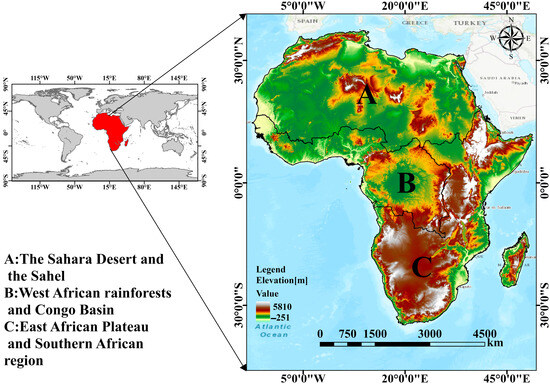
Figure 1.
Geographical location and zoning of Africa, where the colour bar represents the altitude (elevation), and the continent is divided into three regions: A, B, and C.
2.2. Materials and Methods
In this study, CALIPSO satellite data were used to investigate the optical-physical properties of aerosols and clouds and their climatic roles. Operating in a 705 km Sun-synchronous orbit, CALIPSO achieves near-global coverage (82° N–82° S) with approximately 16 daily orbits, enhancing global-scale aerosol and cloud characterisation through high-resolution and high-sensitivity measurements [25,34].
CALIPSO carries the CALIOP active lidar system and two passive sensors (in the visible and thermal infrared bands). In CALIOP, a dual-wavelength (532 nm and 1064 nm) polarisation-sensitive lidar, the 532 nm channel is subdivided into vertical and horizontal polarisation components. This enables the detection of the aerosol/cloud phase, altitude, thickness, optical depth, and type. Its six-order dynamic range supports precise vertical profiling of aerosol–cloud interactions [27].
CALIOP data are classified into three levels, of which the Level 2 (L2) aerosol layer and cloud datasets (5 km horizontal resolution) were considered in this study. Variables including TAODaa, AODna, Hbna, HTna, DRna, SRna, TAODac, AODlc, HTlc, HBlc, DRlc, and SRlc were directly extracted from L2 datasets (see Appendix A Table A1). Variables Vna, PAODna, Vlc, and PAODlc were derived indirectly using the following formulae:
OFlc was calculated as the ratio of low-cloud occurrence counts to total cloud occurrence counts within the 1° × 1° grids sampled by CALIPSO. These variables were selected based on their capability to characterize the optical properties (e.g., TAODaa, AODlc) and vertical structures (e.g., Hbna, HTlc) of aerosols and low clouds, which are crucial for investigating aerosol–cloud interactions over Africa.
A rigorous workflow was designed and implemented that consisted of five key phases:
- (1)
- Data Acquisition and Quality Control. Data were obtained from authoritative sources including NASA Langley Atmospheric Science Research Center. Stringent parameter screening (see Appendix A Table A2) was applied to ensure reliability, with only low-cloud data (base height < 2.5 km) retained for subsequent analysis.
- (2)
- Data Preprocessing. Spatiotemporal matching was performed after categorising data by the African sub-regions, to ensure temporal and spatial consistency between the cloud and aerosol datasets to establish a unified analytical framework.
- (3)
- Spatiotemporal Variation Analysis. In-depth analyses of the optical-physical parameters of low clouds were conducted, with a focus on their diurnal/seasonal variations across three representative African regions using seasonal statistics.
- (4)
- Statistical Analysis. Correlation analyses were conducted to elucidate the intrinsic relationships among low-cloud parameters and their interactions with aerosol metrics, and to reveal potential coupling mechanisms between low-cloud systems and aerosol layers.
- (5)
- Interpretation. The optical-physical properties of low clouds/aerosols and their dynamics were systematically evaluated within the geographic, meteorological, and environmental context of Africa. The impacts of aerosols on cloud microphysics, radiative effects, and cascading climatic feedbacks were critically examined.
The study spanned the period 2006–2021, with seasons defined as MAM (March–May), JJA (June–August), SON (September–November), and DJF (December–February).
3. Results and Discussion
3.1. Seasonal and Spatial Patterns in the Radiative Characteristics of Africa
Seasonal analyses of the optical-physical parameters of low clouds over Africa (2006–2021) revealed distinct diurnal and vertical distribution patterns (Figure 2, Figure 3, Figure 4, Figure 5, Figure 6 and Figure 7, Table A3 and Table A4). OFlc, which is defined by historical meteorological data, synoptic conditions, AOD, and terrain features, exhibited marked spatial heterogeneity. Elevated probabilities were observed along the western Indian Ocean coast (15° S–30° S), probably associated with the Mozambique Current and orographic effects from coastal mountains and plateaus. Region B exhibited higher OFlc values compared to other areas, which are attributable to the humid tropical rainforest climate of the Congo Basin, which promotes persistent low-cloud coverage [35]. In contrast, Region A (dominated by arid/semi-arid climates, including the Sahara Desert) showed lower OFlc values, except near the Mediterranean coast where wintertime marine moisture influx moderately increased the occurrence of low clouds [36]. Region C displayed enhanced probabilities in coastal zones and the Transvaal Plateau, driven by marine humidity and topographic uplift. Seasonally, peak OFlc emerged during June–August (JJA), coinciding with the African wet season, which is characterised by enhanced moisture transport and precipitation. Nocturnal probabilities consistently exceeded daytime values, probably influenced by nocturnal surface radiative cooling, reduced anthropogenic disturbances, and favourable humidity regimes.
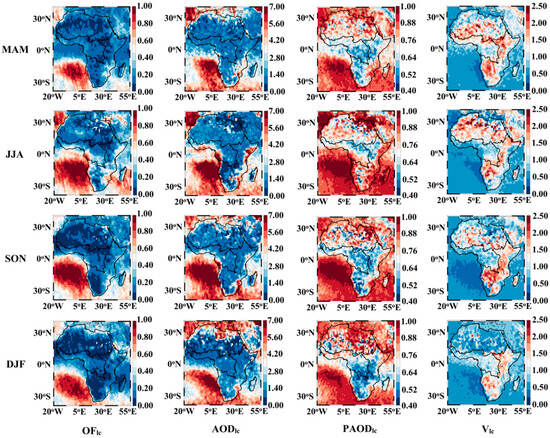
Figure 2.
Seasonal spatial distributions of the frequency of low-cloud occurrence (OFlc), low-cloud AOD (AODlc), low-cloud AOD proportion (PAODlc), and low-cloud vertical depth (Vlc) over Africa during the day.
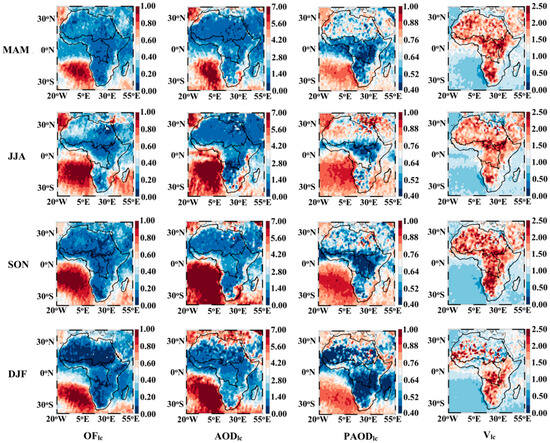
Figure 3.
Seasonal spatial distributions of OFlc, AODlc, PAODlc, and Vlc over Africa during the night.
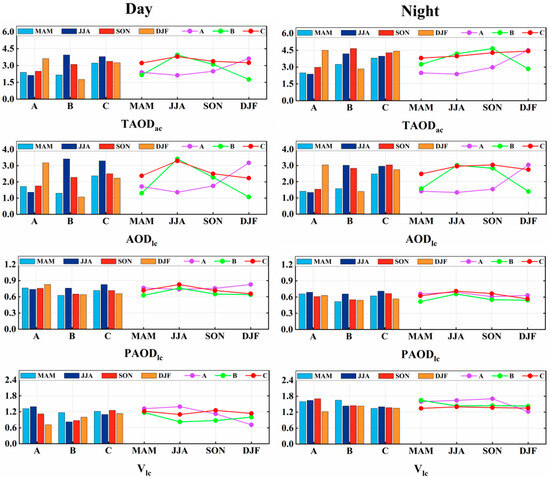
Figure 4.
Seasonal and regional variation in TAODac, AODlc, PAODlc, and Vlc over Africa during the day and night.
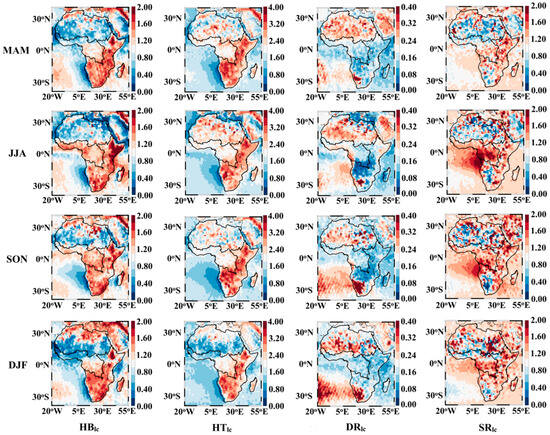
Figure 5.
Seasonal spatial distributions of low-cloud base height (HBlc), low-cloud top height (HTlc), low-cloud depolarisation ratio (DRlc), and low-cloud spectral reflectance ratio (SRlc) over Africa during the day.
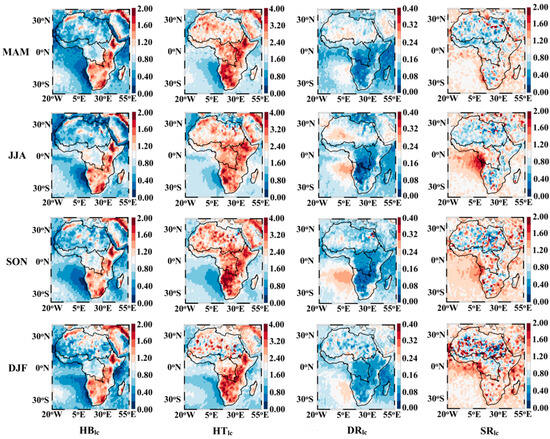
Figure 6.
Seasonal spatial distributions of HBlc, HTlc, DRlc, and SRlc over Africa during the night.
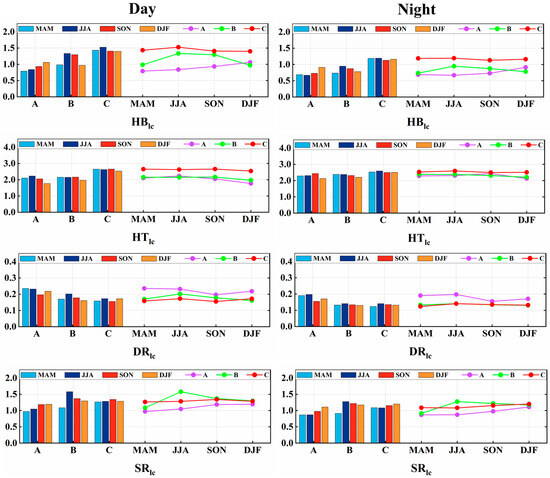
Figure 7.
Seasonal and regional variation in HBlc, HTlc, DRlc, and SRlc over Africa during the day and night.
AODlc over Africa exhibited pronounced seasonal and regional variations (Figure 2, Figure 3 and Figure 4, Table A3 and Table A4). In North Africa (Region A), higher values were observed during the dry season (DJF) compared to other seasons. The Mediterranean coastal zone recorded the highest AODlc extremes (daytime: 4.35–6.58; nighttime: 4.02–6.14), representing grid-cell level maxima within the study domain. This was followed by the Sahara Desert and its periphery (daytime: 1.47–5.56; nighttime: 1.36–5.62), while the Sahel region showed the lowest values (daytime: 0.32–2.67; nighttime: 0.27–2.88). The elevated AODlc over the Sahara and surrounding areas are likely to stem from frequent dust activities, where wind-blown sand particles interact with low clouds, enhancing their optical thickness [29,37]. The Mediterranean coast exhibited higher AODlc values than inland deserts, a finding that is attributed to dense urban populations, industrial emissions, and transported dust [38,39]. In Region B, JJA AODlc values (daytime: 3.42; nighttime: 3.02) significantly exceeded those of other seasons, driven by elevated aerosol concentrations during the transitional period from the dry to the wet seasons (June–August). Residual dust and combustion particles from the dry season persisted due to insufficient rainfall, while wet-season precipitation was not yet dominant [40]. Coastal areas (daytime: 3.28–5.62; nighttime: 3.02–5.85) exhibited marginally higher AODlc values than inland rainforests (daytime: 0.27–2.86; nighttime: 0.23–2.88), possibly due to the mixed aerosol sources (marine and anthropogenic emissions) in coastal zones, in contrast to the natural aerosols dominating inland [41]. Region C had analogous AODlc trends to Region B.
The seasonal mean PAODlc had higher values over oceans than over land, a finding that was attributed to vigorous sea surface evaporation and abundant moisture favouring the formation of low clouds. During dry seasons, North and Southern Africa displayed significantly elevated PAODlc due to dust emissions and biomass burning, while in Central Africa, moderate and stable levels were maintained. Across all three regions, PAODlc declined in rainy seasons under high humidity and frequent precipitation. A spatial analysis revealed distinct mechanisms: North Africa, dominated by dust aerosols, experienced sharp increases in PAODlc during winter dust storms (daytime: 0.47–0.97; nighttime: 0.42–0.83). Central Africa, which was characterised by natural aerosols, showed relatively low values of PAODlc (daytime: 0.43–0.87; nighttime: 0.43–0.81), which were modulated by monsoon dynamics and intense convective systems. In Eastern and Southern Africa, there were marked enhancements in PAODlc in dry seasons (daytime: 0.49–0.98; nighttime: 0.44–0.82), particularly in Southern Africa; these were driven by intensified biomass burning and long-range dust transport. Diurnal variations gave systematically higher daytime PAODlc, probably as a result of solar-induced surface heating promoting vertical air motion and moisture condensation, coupled with enhanced aerosol activation and convective vertical transport of surface aerosols [42,43].
Figure 2, Figure 3 and Figure 4 and Table A3 and Table A4 reveal that the daytime Vlc values were consistently lower than nocturnal values. This pattern was attributed to nighttime surface cooling-induced temperature inversions suppressing vertical convection, leading to the accumulation of low clouds near the surface and increased thickness. In Region B, daytime seasonal Vlc averages (MAM: 1.17, JJA: 0.82, SON: 0.87, DJF: 1.00) remained below those for the other regions; this was likely to be because they were constrained by convective height limitations and geographic positioning [44]. The elevated surrounding topography restricted vertical cloud development, while the Congo Basin’s inland location (compared to coastal areas) increased the export of moisture via daytime trade wind circulation, despite substantial local evaporation. This moisture competition during cloud formation impeded the development of thicker cloud layers [40].
For HBlc and HTlc, there was a positive correlation with geographic elevation across regions, where higher altitudes corresponded to elevated HBlc and HTlc values. Region C had the highest seasonal mean HBlc, followed by Region B, while Region A had the lowest. In North Africa, HBlc underwent pronounced seasonal variability, with lower values in MAM (daytime: 0.79, nighttime: 0.69) and higher values in DJF (daytime: 1.06, nighttime: 0.91). Central, Eastern, and Southern Africa had lower HBlc values during humid periods but elevated values in dry seasons (JJA). HTlc across all regions was reduced during December–February (DJF), which was attributed to weak convective activity and cold air-moisture convergence in North Africa, while reduced cloud coverage in dry seasons contributed to lower HTlc in Regions B and C. Diurnally, the elevated daytime HTlc over Africa was driven by surface heating and inversion layer dynamics, whereas the higher nighttime HTlc resulted from stable atmospheric stratification and radiative cooling [45].
DRlc, which reflects the regularity of cloud particles, decreased with enhanced particle sphericity [46]. Figure 5, Figure 6 and Figure 7 and Table A3 and Table A4 revealed elevated DRlc values in the Sahara Desert (daytime: 0.09–0.36; nighttime: 0.07–0.32) and Kalahari Desert (daytime: 0.10–0.38; nighttime: 0.08–0.33), indicating irregular particle morphologies. Conversely, lower DRlc values were observed in Central African rainforests (daytime: 0.06–0.15; nighttime: 0.05–0.13) and East African highlands/coastal zones (daytime: 0.05–0.18; nighttime: 0.05–0.15), with savannah regions exhibiting intermediate values (daytime: 0.06–0.21; nighttime: 0.05–0.19). This pattern was likely to have been driven by frequent dust activity in desert regions, where irregularly shaped dust aerosols altered the polarisation properties of light during cloud interactions [47]. In temporal terms, coastal zones had lower DRlc (spherical particles) in winter, while arid inland regions had higher DRlc (irregular particles). In summer, humid areas (e.g., rainforests, highlands) showed reduced DRlc, in contrast to the elevated values in arid zones (e.g., the Saharan periphery). Diurnally, the higher daytime DRlc over Africa was attributed to enhanced vertical convection, disrupted inversion layers, and humidity fluctuations, which collectively promote irregular particle shapes [48]. Nighttime DRlc declined under stable atmospheric conditions.
Figure 5, Figure 6 and Figure 7 and Table A3 and Table A4 show the spatiotemporal seasonal variations in SRlc across the three regions of Africa. SRlc, a parameter reflecting cloud particle size, showed a positive correlation with particle diameter [49]. In spatial terms, Region B exhibited the highest SRlc values, followed by Region C, while Region A registered the lowest values. This spatial pattern was attributed to the location of Region B within the Congo Basin, which was persistently governed by the equatorial low-pressure zone [40]. The resultant ascending airflows, abundant precipitation, and high atmospheric humidity facilitated the enlargement of cloud particles in low-cloud layers. Region C, which encompassed the Ethiopian Highlands, East African Plateau, and South African Plateau, had notably elevated SRlc values. Its high-altitude topography intensified mountain-valley breezes: Nocturnal katabatic winds advected cold air downslope, which converged with warm, moist air in valleys to enhance condensation and promote cloud particle growth. Diurnal anabatic winds transported valley moisture upslope, further amplifying the particle size during ascent [50]. In contrast, Region A, influenced by subtropical high-pressure systems and trade winds, experienced arid conditions with minimal precipitation, leading to suppressed SRlc values. From a seasonal perspective, Mediterranean climate zones in North and South Africa showed pronounced SRlc variability, with higher values observed from September to February compared to March–August. Tropical rainforest and savanna climates in Central and East Africa had distinct wet–dry season cycles, where SRlc peaked during wet seasons and declined in dry periods. SRlc values were systematically higher in the daytime than at night. This diurnal asymmetry was likely to be driven by intensified solar radiation elevating surface temperatures, which enhanced atmospheric moisture evaporation and fostered larger cloud particles [51]. In addition, daytime convective activity strengthened turbulence and updrafts, further facilitating the formation of larger cloud droplets.
3.2. Spatiotemporal Correlation Analysis of the Optical Properties of Low Clouds
To investigate the spatiotemporal patterns of low-cloud optical-physical properties over Africa, Pearson correlation coefficients were employed to quantify the relationships among the key low-cloud parameters. For the correlation analysis of optical parameters in regions A, B, and C, Pearson’s correlation coefficients were calculated using raw, unweighted variable values within each region–season subset. Heatmaps were generated to visualise parameter correlations (Figure 8 and Figure 9), and strong positive correlations (R > 0.88) between HTlc and Vlc were consistently observed across African regions A, B, and C, indicating that stable atmospheric conditions facilitated concurrent cloud base/top elevation and vertical development. This covariation was attributed to synergistic mechanisms involving atmospheric circulation and moisture transport, convective activity, topographic influences, and stable atmospheric conditions [52].
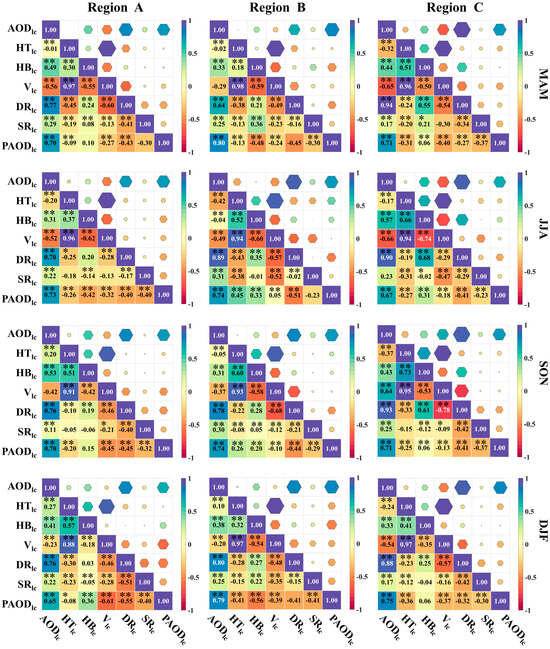
Figure 8.
Heatmaps of daytime low-cloud variable correlations in Regions A, B, and C across Africa. Color bars range from −1 (perfect negative) to 1 (perfect positive). Upper-right hexagons encode correlation strength (larger hexagons = stronger) and direction (blue = positive, red = negative). Lower-right numerical values show correlation magnitudes; asterisks denote significance (* p < 0.05, ** p < 0.01). Variable details are in Table A1.
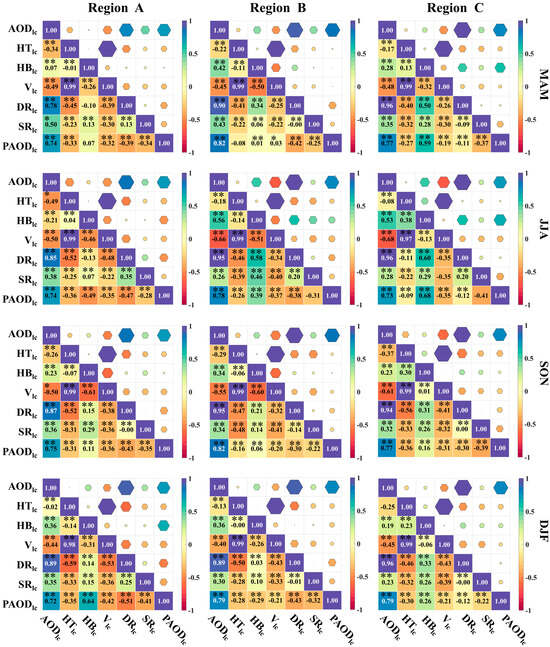
Figure 9.
Heatmaps of nighttime low-cloud variable correlations in Regions A, B, and C across Africa. Color bars range from −1 (perfect negative) to 1 (perfect positive). Upper-right hexagons encode correlation strength (larger hexagons = stronger) and direction (blue = positive, red = negative). Lower-right numerical values show correlation magnitudes; asterisks denote significance (* p < 0.05, ** p < 0.01). Variable details are in Table A1.
When analysing the relationship between AODlc and DRlc across the three African regions, a generally strong positive correlation (R > 0.64) was observed, though regional variations existed. The most pronounced correlation (R > 0.88) was found for Region C (Eastern/Southern Africa), which was driven by monsoon and marine airflow enhancing emissions from biomass burning. Elevated aerosol concentrations increased AOD, while biomass-derived fine particulates acted as cloud condensation nuclei, reducing the size of cloud droplets and increasing the scattering efficiency, thereby amplifying depolarisation ratios [53]. Region A (North Africa) showed a moderate correlation (R > 0.70), primarily influenced by dust aerosols from the Sahara Desert. These aerosols had inherently high depolarisation ratios, and facilitated cloud development despite complex microphysical interactions [48]. Region B (Central African countries) showed the weakest correlation (R > 0.64), as the heterogeneous terrain and diverse climate modulated by multiple meteorological systems, combined with lower aerosol source concentrations relative to other regions, atmospheric instability, and variable cloud structures with moisture distribution patterns, resulted in less pronounced AODlc-DRlc coupling compared to Regions C and A.
It can be seen from the figure that there was a slightly strong positive correlation (R > 0.65) between AODlc and PAODlc. This effect may be closely related to the aerosol sources, the transport pathways in the African region, and the microphysical properties of low clouds. For example, in regions with high aerosol concentrations (such as North Africa, where dust was active, or Eastern and Southern Africa, where biomass burning occurred frequently), more aerosol particles served as cloud condensation nuclei, promoting the formation and development of low clouds, thus increasing the contribution proportion of low clouds to the total AOD. Meanwhile, low clouds themselves have strong extinction ability, which further intensified this positive correlation [54]. This relationship therefore reflected the remarkable characteristics of the aerosol–cloud interaction in the African region and its impacts on radiation and climate. The correlation at night was higher than during the day, probably because the atmosphere was stable at night and there was a lack of solar radiation, and the content of aerosol particles in low clouds was relatively high, leading to an increase in PAODlc. This finding was consistent with the conclusions of Jiang et al. [45].
There was a moderately strong negative correlation between HBlc and Vlc in Africa, and there were significant variations in this relationship in different regions and seasons. Specifically, the negative correlation (−0.74 < R < −0.60) was highest during the daytime from June to August. This might be because the enhanced convective activities in summer led to the lifting of cloud bases and the thinning of cloud layers. The moist air brought by the monsoon increased the opportunities for cloud formation, but due to the convective effect, the cloud layers became thinner [55]. In addition, the influence of dust and aerosols from biomass burning during this period strengthened this negative correlation. In contrast, the negative correlation was the lowest from December to February, mainly because the atmosphere was stable in winter, the vertical movement weakened, and the changes in cloud base height and cloud thickness were relatively small. At the same time, the sparse precipitation in the dry season reduced the aerosol concentration, decreasing the impact on cloud characteristics. In spatial terms, Region B exhibited the highest correlation, followed by Region C, with Region A showing the weakest correlation. These spatial disparities were likely driven by the combined effects of geographic positioning, seasonal meteorological conditions, and aerosol–cloud interactions.
A negative correlation was generally observed between Vlc and AODlc. This relationship was primarily attributed to the radiative effects of absorptive aerosols (e.g., dust and biomass burning particles), which warmed the atmosphere through shortwave radiation absorption. This heating stabilised the lower troposphere and suppressed convective updrafts, thereby reducing vertical moisture transport. This dual effect limited vertical cloud development and thinned the low cloud layers. Notably, however, a distinct positive correlation emerged in Region C from September to November. This anomaly coincided with the transitional dry-to-wet season period, during which aerosols from biomass burning and dust transport were enhanced. Despite elevated AOD levels, these aerosols probably increased CCN availability, and may have promoted cloud thickening through enhanced droplet activation.
Finally, a negative correlation was observed between Vlc and DRlc across Africa, with notable regional and seasonal variations. During the peak wet season from June to August, particularly in Region A, frequent convective activities resulted in greater low cloud thickness. Meanwhile, the effect of multiple scattering reduced the sensitivity to changes in the depolarisation ratio, causing the negative correlation between low cloud thickness and depolarisation ratio to reach its lowest. In contrast, during the transitional season from September to November, Region C was under the control of the subtropical high-pressure system, leading to thinner low clouds but the highest negative correlation of the depolarisation ratio.
3.3. Interrelation of Properties Between Low Clouds and the Lowest Aerosol Layer
To gain a deeper understanding of the influence of aerosols on the formation, distribution, and variability of low clouds, we also analysed the interrelationships between the physical and optical properties of low clouds and the lowest aerosol layer across three African regions, as illustrated in Figure 9 and Figure 10. The results revealed a discernible correlation between AODna and the PAODlc, with variations across diurnal cycles and seasonal transitions. Notably, there was a strong positive correlation in Regions A and B between AODna and PAODlc. This phenomenon may be attributed to the abundance of dust aerosols in the Sahara Desert, coupled with atmospheric circulation patterns and moisture-rich conditions in rainforests, as well as frequent convective activities in the Congo Basin. Specifically, the Sahara’s dust aerosols are likely to have provided ample CCN for low-cloud formation under favourable humidity conditions. Concurrently, intense upward motions in the rainforest and Congo Basin regions transported surface aerosols to higher altitudes, enhancing the availability of CCN for low clouds [56]. These convective processes also promoted water vapour condensation at varying altitudes, thereby increasing the frequency and spatial extent of low clouds and reinforcing the observed correlation. The analysis also indicated that the correlation between AODna and PAODlc underwent seasonal dependencies. During the daytime in the autumn, weaker correlations were observed compared to the other seasons. The seasonal weakening of correlations in autumn paralleled Grist et al.’s identification of reduced aerosol–cloud coupling under weakened atmospheric drivers, underscoring the climatic context-dependent nature of these interactions [57]. This may be linked to the reduced influence of the subtropical high-pressure zone and trade winds over the Sahara Desert, alongside diminished land–sea thermal contrasts affecting monsoon circulation and weaker equatorial low-pressure impacts in the rainforest and Congo Basin, leading to less pronounced convective activity [58]. The correlation between ADOna and PAODlc was also stronger at night than during the day. This nocturnal enhancement may stem from increased atmospheric stability, reduced turbulence, and altered cloud microphysical processes under nighttime conditions [45].
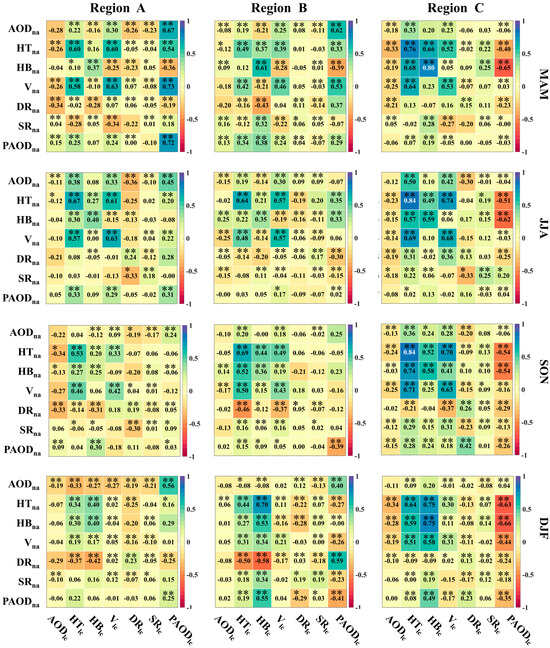
Figure 10.
Heatmaps of variable correlations across different regions. Each heatmap displays the correlation coefficients between the low-cloud and aerosol variables in Regions A, B, and C over Africa during the day. Details of the variables are given in Table A1. Asterisks indicate the significance level: * p < 0.05 (significant), ** p < 0.01 (highly significant). Non-significant correlations (p ≥ 0.05) are left unmarked.
Figure 10 and Figure 11 show distinct correlations between HTna and HTlc across the three African regions. Region C showed the strongest positive correlation; this can probably be attributed to its geographical complexity, as it encompasses the East African Plateau and southern African plains, where intense convective activity and substantial biomass burning enhanced aerosol–cloud interactions [59]. Region B showed higher correlations than Region A during the SON-DJF seasons due to reduced precipitation and increased biomass burning, but lower correlations in the MAM-JJA seasons when heavy rainfall suppressed convection. The correlation between HTna and Vlc also underwent regional disparities, with Region C maintaining the strongest positive association. This phenomenon was closely linked to combined anthropogenic emissions and natural sources in Eastern/Southern Africa, where aerosol layers (at an altitude of 3–5 km) interacted with frequent convection, abundant moisture, and land–sea exchanges. Region B (Central Africa) exhibited higher Vna–Vlc correlations than Region A in SON-DJF, but lower correlations in MAM-JJA, a pattern primarily governed by humidity variations and aerosol hygroscopicity [60]. Similar correlation characteristics were observed between Vna and HTlc. The positive correlations between HBna and HBlc peaked in Region C, driven by vigorous convection and pronounced land–ocean interactions. The next strongest was Region B, which benefited from tropical rainforest moisture supply, while Region A showed the weakest correlations due to arid conditions limiting low cloud formation. All three regions showed seasonally modulated positive correlations between Vna and Vlc, with stronger associations in the MAM-JJA seasons. This seasonal pattern is likely to stem from enhanced convective activity, increased moisture availability, and biomass burning variations during warm seasons [61].
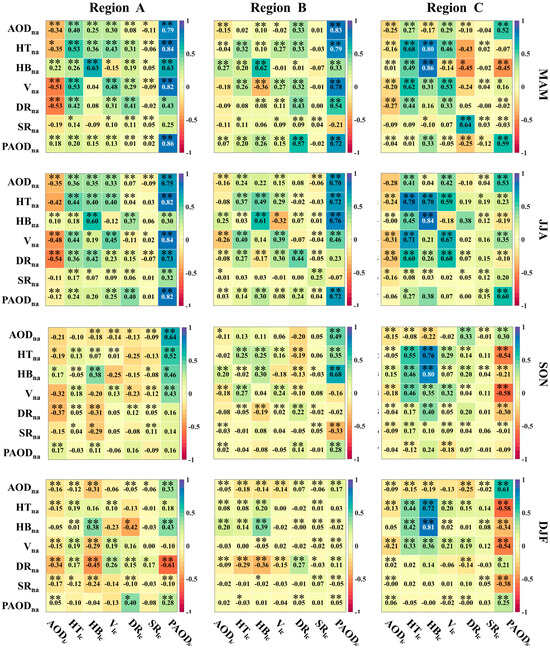
Figure 11.
Heatmaps of the variable correlations across different regions. Each heatmap displays the correlation coefficients between low-cloud and aerosol variables in Regions A, B, and C over Africa during the night. Details of the variables are given in Table A1. Asterisks indicate the significance level: * p < 0.05 (significant), ** p < 0.01 (highly significant). Non-significant correlations (p ≥ 0.05) are left unmarked.
Across the entire African region, a strong negative correlation between HBna, HTna, and PAODlc was found only for Region C. This phenomenon could be explained by multiple theoretical foundations. Firstly, the aerosol indirect effect meant that when the proportion of aerosols in low-level clouds was high, more aerosol particles acted as cloud condensation nuclei, thus increasing the number of cloud droplets while decreasing the radius of individual droplets. This resulted in thicker and more stable clouds, thereby constraining the vertical extent of the aerosol layer. Secondly, the role of turbulent mixing could not be overlooked. Under the complex topography and frequent convective activities characteristic of Region C, high aerosol concentrations weakened turbulent mixing, further confining the aerosol layer to lower atmospheric levels [62]. Furthermore, Region C’s abundant moisture conditions, which were particularly pronounced during MAM-JJA, intensified cloud–aerosol interactions. High aerosol concentrations altered the efficiency of cloud droplet activation, affecting the vertical structure of clouds and concentrating the aerosol layer near the surface [28]. Finally, the radiative effects of aerosols, through the scattering and absorption of solar radiation, modified the temperature distribution between the surface and atmosphere, enhancing atmospheric stability and suppressing turbulent mixing, which in turn reduced both the base and peak heights of the aerosol layer. In summary, the combined effects of indirect aerosol effects, turbulent mixing, moisture conditions, and radiative effects contributed to the observed negative correlation between HBna/HTna and PAODlc in Region C.
In spring, Region A exhibited strong positive correlations between Vna and PAODlc, as well as between PAODna and PAODlc. This indicated that increases in PAODlc were accompanied by corresponding increases in both Vna and PAODna, reflecting the close interaction between aerosols and low-level clouds and their seasonal characteristics. These correlations probably resulted from a combination of factors, including the region’s unique geographical features (such as proximity to dust sources or active biomass burning zones), seasonal meteorological conditions (such as specific atmospheric circulation patterns that enhanced aerosol accumulation and transport), the distinct nature of aerosol sources (such as the significant impacts of dust or biomass-burning aerosols on low cloud properties), and the mechanisms of low-cloud formation (which are more dependent on aerosols than CCN).
4. Conclusions
Using high-resolution vertical profiling data from the CALIPSO satellite (2006–2021), a comprehensive analysis of the diurnal/nocturnal variations in optical-physical characteristics of low-level clouds across three distinct African subregions was conducted. The study particularly focused on elucidating the mechanisms of vertical aerosol–cloud interaction within these atmospheric regimes. The key scientific outcomes are summarised below:
- (1)
- AODlc (Low-cloud AOD) exhibited distinct seasonal patterns, peaking in the DJF season in Region A, June–November in Regions B and C, and dry seasons overall. The PAODlc (Low-cloud AOD Proportion) results mirrored this trend, with significant increases in the dry seasons across North and Southern Africa but remaining stable in Central Africa. Both parameters showed diurnal variation with higher values in the daytime, probably driven by solar radiation and thermal convection. A strong positive correlation between AODlc and PAODlc persisted continent-wide.
- (2)
- HBlc (Low-cloud base height) and HTlc (Low-cloud top height) showed significant regional disparities over Africa. Seasonally averaged values were highest in Region C and lowest in Region A, with Region B showing intermediate values. In temporal terms, HBlc peaked during the daytime, an effect that is likely to be associated with surface heating and temperature inversion layers, while HTlc increased at night under stable atmospheric conditions enhanced by radiative cooling. Strong positive correlations emerged between HTlc and Vlc (Low-cloud vertical depth) indicating vertical expansion with cloud deepening. Conversely, HBlc displayed moderate negative correlations with Vlc, with notable seasonal and regional variations.
- (3)
- A spatial analysis of DRlc (Low-cloud depolarization ratio) revealed distinct patterns: elevated values over desert regions contrasted with lower DRlc in the Central African rainforest, East African Plateau, and coastal zones. In temporal terms, nighttime DRlc values generally exceeded those during the daytime, a finding that is likely to be linked to nocturnal cloud stabilisation promoting a more spherical cloud particle morphology. Regional variations emerged in the positive correlations between AODlc and DRlc; these peaked in Region C, followed by Region B, and were minimal in Region A. Vlc showed an overall negative correlation with DRlc, with stronger associations during dry seasons than rainy seasons.
- (4)
- A spatiotemporal analysis of SRlc (Low-cloud spectral reflectance ratio) demonstrated distinct geographical gradients: The maximum values occurred in Region B, followed by Region C, while Region A had minimal SRlc values. All three regions showed consistent seasonal patterns, with higher wet-season SRlc compared to dry-season values. On a diurnal basis, enhanced solar radiation and intensified convective activity during the daytime probably promoted water vapor evaporation and the formation of larger cloud particles, resulting in systematically higher daytime SRlc than nocturnal measurements.
- (5)
- Observational analyses revealed pronounced positive correlations between AODna (Near-surface aerosol AOD) and PAODlc in North Africa (Region A) and Central Africa (Region B). Simultaneously, HTna (Near-surface aerosol layer top height) showed positive correlations with HBlc and Vlc across all three regions, while HBna (Near-surface aerosol layer top height) was positively correlated with HBlc, with these relationships demonstrating analogous regional and seasonal patterns. In addition, there were negative correlations in Region C between HBna/HTna and PAODlc. During spring in Region A, strong positive correlations emerged between Vna (Near-surface aerosol layer vertical depth) and PAODlc, as well as between PAODna and PAODlc.
Our findings not only contribute to elucidating region-specific aerosol sources and their ecological impacts, but also provide a scientific basis for enhancing aerosol and low-cloud parameterisation schemes in climate models. Specifically, our comprehensive analysis of aerosol–low cloud interactions across the three regions significantly improves the simulation accuracy of African climate systems, thereby laying the groundwork for more reliable climate projections. This advancement offers valuable support for climate change mitigation, environmental governance optimisation, and the preservation of regional ecological equilibrium.
Author Contributions
B.S.; methodology, B.S. and M.Z.; software, D.L. and X.L.; validation, S.K.; formal analysis, B.S.; investigation, B.S. and X.L.; resources, B.S.; data curation, B.S.; writing—original draft preparation, B.S.; writing—review and editing, W.S.; visualization, B.S.; supervision, S.K.; project administration, B.S.; funding acquisition, M.Z. All authors have read and agreed to the published version of the manuscript.
Funding
This research was supported in part by the Sponsored by Program for Science & Technology Innovation Talents in Universities of Henan Province of China (No. 24HASTIT018), in part by the Natural Science Foundation of Henan Province of China (No. 242300421369), in part by the Program of Undergraduate Universities Young Backbone Teacher Training of Henan Province of China (No. 2024GGJS104), in part by the Nanyang Normal University Scientific Research Project (No. 2025ZX027), and in part by Henan Province Science and Technology R&D Projects (242102320235).
Institutional Review Board Statement
Not applicable.
Informed Consent Statement
Not applicable.
Data Availability Statement
Data are contained within the article.
Acknowledgments
We thank the editors for assisting in the linguistic refinement of this manuscript. And we also thank NASA for providing datasets (https://subset.larc.nasa.gov/calipso/login.php, accessed on 1 March 2024).
Conflicts of Interest
The authors declare no conflicts of interest.
Appendix A

Table A1.
An abbreviated list of aerosol and cloud optical–physical parameters used in this paper.
Table A1.
An abbreviated list of aerosol and cloud optical–physical parameters used in this paper.
| Type | Parameter | Abbreviation |
|---|---|---|
| Aerosol | Total AOD across all aerosol layers | TAODaa |
| Near-surface aerosol AOD | AODna | |
| Near-surface aerosol proportion | PAODna | |
| Near-surface aerosol layer bottom height | HBna | |
| Near-surface aerosol layer top height | HTna | |
| Near-surface aerosol layer vertical depth | Vna | |
| Near-surface aerosol layer depolarization ratio | DRna | |
| Near-surface aerosol layer spectral reflectance ratio | SRna | |
| Cloud | Total AOD across all cloud layers | TAODac |
| All Cloud sampling data from satellite observations | SDac | |
| Low-cloud sampling data from satellite observations | SDlc | |
| Low-cloud occurrence frequency | OFlc | |
| Low-cloud AOD | AODlc | |
| Low-cloud top height | HTlc | |
| Low-cloud base height | HBlc | |
| Low-cloud vertical depth | Vlc | |
| Low-cloud depolarization ratio | DRlc | |
| Low-cloud spectral reflectance ratio | SRlc | |
| Low-cloud AOD Proportion | PAODlc |

Table A2.
Parametric data filtering range.
Table A2.
Parametric data filtering range.
| Parameter | Elevation Selection Range (km) |
|---|---|
| HBlc, HBna | 0~2.5 |
| DRlc, DRna | 0~5 |
| SRlc, SRla | 0~10 |
| AODlc, AODna | 0~20 |
| TAODc, TAODa | 0~30 |
| Vlc, Vna | 0~30 |
Appendix B

Table A3.
Seasonal mean and standard deviation values of eight variables during the day over Africa (Three regions: A, B, C).
Table A3.
Seasonal mean and standard deviation values of eight variables during the day over Africa (Three regions: A, B, C).
| Region | Season | Day | |||||||
|---|---|---|---|---|---|---|---|---|---|
| TAODac | AODlc | HTlc | HBlc | Vlc | DRlc | SRlc | PAODlc | ||
| A | MAM | 2.38 ± 3.16 | 1.71 ± 2.89 | 2.11 ± 0.62 | 0.79 ± 0.62 | 1.32 ± 1.00 | 0.24 ± 0.15 | 0.97 ± 1.18 | 0.76 ± 0.31 |
| JJA | 2.13 ± 2.45 | 1.36 ± 1.90 | 2.23 ± 0.95 | 0.84 ± 0.60 | 1.39 ± 1.00 | 0.23 ± 0.16 | 1.05 ± 1.37 | 0.74 ± 0.32 | |
| SON | 2.48 ± 3.24 | 1.75 ± 2.94 | 2.05 ± 0.90 | 0.93 ± 0.67 | 1.12 ± 0.86 | 0.20 ± 0.17 | 1.18 ± 1.30 | 0.76 ± 0.32 | |
| DJF | 3.61 ± 4.54 | 3.17 ± 4.56 | 1.77 ± 0.84 | 1.06 ± 0.74 | 0.71 ± 0.53 | 0.22 ± 0.17 | 1.19 ± 0.94 | 0.83 ± 0.30 | |
| B | MAM | 2.16 ± 2.76 | 1.30 ± 2.23 | 2.16 ± 0.86 | 0.99 ± 0.64 | 1.17 ± 0.95 | 0.17 ± 0.16 | 1.08 ± 1.20 | 0.63 ± 0.33 |
| JJA | 3.94 ± 4.77 | 3.42 ± 4.76 | 2.15 ± 0.72 | 1.34 ± 0.56 | 0.82 ± 0.76 | 0.20 ± 0.18 | 1.58 ± 1.17 | 0.76 ± 0.31 | |
| SON | 3.10 ± 3.90 | 2.28 ± 3.75 | 2.16 ± 0.79 | 1.30 ± 0.61 | 0.87 ± 0.79 | 0.18 ± 0.20 | 1.37 ± 1.16 | 0.65 ± 0.34 | |
| DJF | 1.76 ± 2.52 | 1.07 ± 2.06 | 1.97 ± 0.88 | 0.97 ± 0.64 | 1.00 ± 0.83 | 0.16 ± 0.16 | 1.30 ± 1.27 | 0.64 ± 0.33 | |
| C | MAM | 3.22 ± 3.84 | 2.38 ± 3.71 | 2.65 ± 0.86 | 1.44 ± 0.63 | 1.22 ± 0.89 | 0.16 ± 0.20 | 1.27 ± 1.28 | 0.72 ± 0.34 |
| JJA | 3.80 ± 4.63 | 3.30 ± 4.64 | 2.62 ± 0.78 | 1.53 ± 0.66 | 1.10 ± 0.84 | 0.17 ± 0.17 | 1.28 ± 1.08 | 0.83 ± 0.29 | |
| SON | 3.37 ± 4.04 | 2.50 ± 3.94 | 2.66 ± 0.89 | 1.41 ± 0.62 | 1.25 ± 0.92 | 0.16 ± 0.22 | 1.34 ± 1.31 | 0.72 ± 0.34 | |
| DJF | 3.24 ± 3.66 | 2.23 ± 3.47 | 2.53 ± 0.92 | 1.40 ± 0.63 | 1.13 ± 0.87 | 0.17 ± 0.24 | 1.29 ± 1.30 | 0.66 ± 0.35 | |

Table A4.
Seasonal mean and standard deviation values of eight variables during the night over Africa (Three regions: A, B, and C).
Table A4.
Seasonal mean and standard deviation values of eight variables during the night over Africa (Three regions: A, B, and C).
| Region | Season | Night | |||||||
|---|---|---|---|---|---|---|---|---|---|
| TAODac | AODlc | HTlc | HBlc | Vlc | DRlc | SRlc | PAODlc | ||
| A | MAM | 2.47 ± 2.93 | 1.42 ± 2.33 | 2.29 ± 1.46 | 0.69 ± 0.51 | 1.60 ± 1.41 | 0.19 ± 0.09 | 0.87 ± 1.26 | 0.66 ± 0.36 |
| JJA | 2.37 ± 2.68 | 1.34 ± 1.98 | 2.31 ± 1.50 | 0.67 ± 0.50 | 1.64 ± 1.45 | 0.20 ± 0.08 | 0.87 ± 1.24 | 0.69 ± 0.35 | |
| SON | 2.97 ± 3.06 | 1.54 ± 2.40 | 2.43 ± 1.54 | 0.73 ± 0.56 | 1.70 ± 1.52 | 0.16 ± 0.10 | 0.98 ± 1.35 | 0.61 ± 0.38 | |
| DJF | 4.49 ± 4.02 | 3.04 ± 4.11 | 2.13 ± 1.25 | 0.91 ± 0.66 | 1.22 ± 1.19 | 0.17 ± 0.11 | 1.11 ± 1.24 | 0.63 ± 0.40 | |
| B | MAM | 3.24 ± 3.27 | 1.57 ± 2.39 | 2.38 ± 1.76 | 0.73 ± 0.54 | 1.65 ± 1.73 | 0.13 ± 0.09 | 0.13 ± 1.25 | 0.52 ± 0.34 |
| JJA | 4.18 ± 4.16 | 3.02 ± 3.95 | 2.38 ± 1.33 | 0.77 ± 0.60 | 1.43 ± 1.24 | 0.14 ± 0.11 | 1.28 ± 1.26 | 0.66 ± 0.35 | |
| SON | 4.65 ± 3.89 | 2.83 ± 3.60 | 2.32 ± 1.54 | 0.87 ± 0.59 | 1.44 ± 1.49 | 0.13 ± 0.11 | 1.22 ± 1.34 | 0.55 ± 0.36 | |
| DJF | 2.82 ± 3.12 | 1.40 ± 2.29 | 2.21 ± 1.53 | 0.78 ± 0.56 | 1.43 ± 1.46 | 0.13 ± 0.09 | 1.17 ± 1.42 | 0.54 ± 0.35 | |
| C | MAM | 3.80 ± 3.66 | 2.48 ± 3.46 | 2.53 ± 1.27 | 1.19 ± 0.62 | 1.34 ± 1.16 | 0.12 ± 0.11 | 1.09 ± 1.21 | 0.62 ± 0.37 |
| JJA | 3.97 ± 4.03 | 2.96 ± 4.04 | 2.59 ± 1.19 | 1.19 ± 0.65 | 1.40 ± 1.02 | 0.14 ± 0.11 | 1.08 ± 1.14 | 0.71 ± 0.36 | |
| SON | 4.27 ± 4.10 | 3.04 ± 4.07 | 2.50 ± 1.29 | 1.13 ± 0.60 | 1.37 ± 1.13 | 0.14 ± 0.12 | 1.15 ± 1.25 | 0.67 ± 0.37 | |
| DJF | 4.42 ± 3.85 | 2.75 ± 3.69 | 2.51 ± 1.35 | 1.16 ± 0.60 | 1.35 ± 1.22 | 0.13 ± 0.12 | 1.20 ± 1.32 | 0.57 ± 0.37 | |
References
- Kaufman, Y.J.; Tanre, D.; Boucher, O. A satellite view of aerosols in the climate system. Nature 2002, 419, 215–223. [Google Scholar] [CrossRef] [PubMed]
- Stevens, B.; Feingold, G. Untangling aerosol effects on clouds and precipitation in a buffered system. Nature 2009, 461, 607–613. [Google Scholar] [CrossRef]
- Novakov, T.; Penner, J.E. Large contribution of organic aerosols to cloud-condensation-nuclei concentrations. Nature 1993, 365, 823–826. [Google Scholar] [CrossRef]
- Jimenez, J.L.; Canagaratna, M.R.; Donahue, N.M.; Prevot, A.S.H.; Zhang, Q. Evolution of Organic Aerosols in the Atmosphere. Science 2009, 326, 1525–1529. [Google Scholar] [CrossRef]
- Bellouin, N.; Boucher, O.; Haywood, J.; Reddy, M.S. Global estimate of aerosol direct radiative forcing from satellite measurements. Nature 2005, 438, 1138–1141. [Google Scholar] [CrossRef] [PubMed]
- Ramanathan, V.; Crutzen, P.J.; Kiehl, J.T.; Rosenfeld, D. Aerosols, Climate, and the Hydrological Cycle. Science 2001, 294, 2119–2124. [Google Scholar] [CrossRef]
- Anderson, T.L. Atmospheric science. Climate forcing by aerosol—A hazy picture. Science 2003, 300, 1103–1104. [Google Scholar] [CrossRef]
- Li, Z.; Guo, J.; Ding, A.; Liao, H.; Zhu, B. Aerosol and boundary-layer interactions and impact on air quality. Natl. Sci. Rev. 2017, 4, 810–833. [Google Scholar] [CrossRef]
- Sherwood, S.; Rosenfeld, D.; Donner, L.; Wood, R. Climate Effects of Aerosol-Cloud Interactions. Science 2014, 343, 379–380. [Google Scholar]
- Claeys, M.; Graham, B.; Vas, G.; Wang, W.; Vermeylen, R.; Pashynska, V.; Cafmeyer, J.; Cuyon, P.; Andreae, M.O.; Artaxo, P. Formation of Secondary Organic Aerosols Through Photooxidation of Isoprene. Science 2004, 303, 1173–1176. [Google Scholar] [CrossRef]
- Johnson, B.T.; Heese, B.; Mcfarlane, S.A.; Chazette, P.; Jones, A.; Bellouin, N. Vertical distribution and radiative effects of mineral dust and biomass burning aerosol over West Africa during DABEX. J. Geophys. Res. 2008, 113, D00C12. [Google Scholar] [CrossRef]
- Lee, S.S.; Donner, L.J.; Phillips, V.T.J. Cloud and aerosol effects on radiation in deep convective clouds: Comparison with warm stratiform clouds. Atmos. Chem. Phys. 2008, 8, 15291–15341. [Google Scholar]
- Leung, G.R.; Saleeby, S.M.; Sokolowsky, G.A.; Freeman, S.W.; Vandenheever, S. Aerosol–cloud impacts on aerosol detrainment and rainout in shallow maritime tropical clouds. Atmos. Chem. Phys. 2023, 23, 5263–5278. [Google Scholar] [CrossRef]
- Kiehl, J.T.; Briegleb, B.P. The relative roles of sulfate aerosols and greenhouse gases in climate forcing. Science 1993, 260, 311–314. [Google Scholar] [CrossRef]
- Toll, V.; Christensen, M.; Quaas, J.; Bellouin, N. Weak average liquid-cloud-water response to anthropogenic aerosols. Nature 2019, 572, 51–55. [Google Scholar] [CrossRef]
- Broccoli, A.J.; Klein, S.A. Comment on “Observational and Model Evidence for Positive Low-Level Cloud Feedback”. Science 2010, 329, 277. [Google Scholar] [CrossRef]
- Cess, R.D.; Potter, G.L.; Blanchet, J.P.; Boer, G.J.; Ghan, S.J.; Kiehl, J.T.; Le Treut, H.; Li, Z.X.; Liang, X.Z.; Mitchell, J.F.B. Interpretation of Cloud-Climate Feedback as Produced by 14 Atmospheric General Circulation Models. Science 1989, 245, 513–516. [Google Scholar] [CrossRef]
- Clement, A.C.; Burgman, R.; Norris, J.R. Observational and Model Evidence for Positive Low-Level Cloud Feedback. Science 2009, 325, 460–464. [Google Scholar] [CrossRef]
- Shikhovtsev, A.Y.; Khaikin, V.B.; Kovadlo, P.G.; Baron, P. Optical Thickness of the Atmosphere above the Terskol Peak. Atmos. Ocean. Opt. 2023, 36, 78–85. [Google Scholar] [CrossRef]
- Khaikin, V.B.; Shikhovtsev, A.Y.; Mironov, A.P. Statistical Characteristics of Precipitated Water Vapor, Optical Depth and Cloudiness in the Northern Part of Russia. Astron. Rep. 2024, 68, 222–232. [Google Scholar] [CrossRef]
- Breon, F.M. How Do Aerosols Affect Cloudiness and Climate? Science 2006, 313, 623–624. [Google Scholar] [CrossRef] [PubMed]
- Li, Z. Influence of Absorbing Aerosols on the Inference of Solar Surface Radiation Budget and Cloud Absorption. J. Clim. 1998, 11, 5–17. [Google Scholar] [CrossRef]
- Sato, Y.; Suzuki, K. How do aerosols affect cloudiness? Science 2019, 363, 580–581. [Google Scholar] [CrossRef] [PubMed]
- Winker, D. The CALIPSO Mission and Initial Observations of Clouds and Aerosols from CALIOP. Proc SPIE 2007, 6509, 1102–1110. [Google Scholar]
- Winker, D.M.; Pelon, J.; Mccormick, M.P. The CALIPSO mission: Spaceborne lidar for observation of aerosols and clouds. Proc SPIE 2003, 4893, 1211–1229. [Google Scholar]
- Kim, S.W.; Berthier, S.; Raut, J.C.; Chazette, P.; Dulac, F.; Yoon, S.C. Validation of aerosol and cloud layer structures from the space-borne lidar CALIOP using a ground-based lidar in Seoul, Korea. Atmos. Chem. Phys. 2008, 8, 3705–3720. [Google Scholar] [CrossRef]
- Pitts, M.C.; Thomason, L.W.; Poole, L.R.; Winker, D.M. Characterization of Polar Stratospheric Clouds with spaceborne lidar: CALIPSO and the 2006 Antarctic season. Atmos. Chem. Phys. 2007, 7, 5207–5228. [Google Scholar] [CrossRef]
- Ntwali, D.; Chen, H. Diurnal spatial distributions of aerosol optical and cloud micro-macrophysics properties in Africa based on MODIS observations. Atmos. Environ. 2018, 182, 252–262. [Google Scholar] [CrossRef]
- Lau, K.M.; Kim, K.M. Cooling of the Atlantic by Saharan dust. Geophys. Res. Lett. 2007, 34, L23811. [Google Scholar] [CrossRef]
- Middleton, N.J. Effect of drought on dust production in the Sahel. Nature 1985, 316, 431–434. [Google Scholar] [CrossRef]
- Getachew, B.; Manjunatha, B.R.; Gangadhara Bhat, H. Spatio-temporal distribution of aerosol optical depth and cloud properties over Lake Tana Basin, Upper Blue Nile River Basin, Ethiopia. Remote Sens. Appl. Soc. Environ. 2020, 20, 100401. [Google Scholar] [CrossRef]
- Nyasulu, M.; Haque, M.M.; Musonda, B.; Fang, C. The long-term spatial and temporal distribution of aerosol optical depth and its associated atmospheric circulation over Southeast Africa. Environ. Sci. Pollut. Res. 2022, 29, 30073–30089. [Google Scholar] [CrossRef] [PubMed]
- Gaetani, M.; Pohl, B.; Alvarez Castro, M.C.; Flamant, C.; Formenti, P. A weather regime characterisation of winter biomass aerosol transport from southern Africa. Atmos. Chem. Phys. 2021, 21, 16575–16591. [Google Scholar] [CrossRef]
- Virts, K.S.; Wallace, J.M.; Fu, Q.; Ackerman, T.P. Tropical Tropopause Transition Layer Cirrus as Represented by CALIPSO Lidar Observations. J. Atmos. Sci. 1912, 67, 3113–3129. [Google Scholar] [CrossRef]
- Lu, X.; Mao, F.; Rosenfeld, D.; Zhu, Y.; Pan, Z.; Gong, W. Satellite retrieval of cloud base height and geometric thickness of low-level cloud based on CALIPSO. Atmos. Chem. Phys. 2021, 21, 11979–12003. [Google Scholar] [CrossRef]
- Yuan, T.; Song, H.; Wood, R.; Oreopoulos, L.; Platnick, S.; Wang, C.; Yu, H.; Meyer, K.; Wilcox, E. Observational evidence of strong forcing from aerosol effect on low cloud coverage. Sci. Adv. 2023, 9, eadh7716. [Google Scholar] [CrossRef]
- García, M.I.; Drooge, B.L.V.; Rodríguez, S.; Alastuey, A. Speciation of organic aerosols in the Saharan Air Layer and in the free troposphere westerlies. Atmos. Chem. Phys. 2017, 14, 8939–8958. [Google Scholar] [CrossRef]
- Despiau, S.; Cougnenc, S.; Resch, F. Marine and atmospheric aerosol measurementson the mediterranean coast. J. Aerosol Sci. 1991, 22, S645–S648. [Google Scholar] [CrossRef]
- Ganor, E.; Levin, Z.; Grieken, R.V. Composition of individual aerosol particles above the Israelian Mediterranean coast during the summer time. Atmos. Environ. 1998, 32, 1631–1642. [Google Scholar] [CrossRef]
- Chakraborty, S.; Jiang, J.H.; Su, H.; Fu, R. On the role of aerosol radiative effect in the wet season onset timing over the Congo rainforest during boreal autumn. Atmos. Chem. Phys. 2021, 21, 12855–12866. [Google Scholar] [CrossRef]
- Herut, B.; Nimmo, M.; Medway, A.; Chester, R.; Krom, M.D. Dry atmospheric inputs of trace metals at the Mediterranean coast of Israel (SE Mediterranean): Sources and fluxes. Atmos. Environ. 2001, 35, 803–813. [Google Scholar] [CrossRef]
- Su, B.; Lin, D.; Liu, Z.; Wu, Q.; Song, W.; Zhang, M. Optical–Physical Characteristics of Low Clouds and Aerosols in South America Based on Cloud-Aerosol Lidar and Infrared Pathfinder Satellite Observation. Atmosphere 2024, 15, 1513. [Google Scholar] [CrossRef]
- Zhang, M.; Mu, P.; Chen, X.; Wu, D.; Lu, F.; Qi, P.; Li, L.B.; Gong, W. Study on the Optical–Physical Properties of Aerosol Layers in Africa Based on a Laser Satellite. Atmosphere 2023, 14, 1524. [Google Scholar] [CrossRef]
- Zhang, J.; Zheng, Y.; Li, Z.; Xia, X.; Chen, H. A 17-year climatology of temperature inversions above clouds over the ARM SGP site: The roles of cloud radiative effects. Atmos. Res. 2020, 237, 104810. [Google Scholar] [CrossRef]
- Jiang, X.; Wang, Y.; Wang, L.; Tao, M.; Wang, J.; Zhou, M.; Bai, X.; Gui, L. Characteristics of Daytime-And-Nighttime AOD Differences Over China: A Perspective from CALIOP Satellite Observations and GEOS-Chem Model Simulations. J. Geophys. Res. Atmos. 2024, 129, e2023JD039158. [Google Scholar] [CrossRef]
- Kim, M.H.; Omar, A.H.; Tackett, J.L.; Vaughan, M.A.; Winker, D.M.; Trepte, C.R.; Hu, Y.; Liu, Z.; Poole, L.R.; Pitts, M.C.; et al. The CALIPSO version 4 automated aerosol classification and lidar ratio selection algorithm. Atmos. Meas. Tech. 2018, 11, 6107–6135. [Google Scholar] [CrossRef] [PubMed]
- Arenas-Díaz, F.; Fuentes, B.; Reyers, M.; Fiedler, S.; Böhm, C.; Campos, E.; Shao, Y.; Bol, R. Dust and aerosols in the Atacama Desert. Earth-Sci. Rev. 2022, 226, 103925. [Google Scholar] [CrossRef]
- Senghor, H.; Machu, É.; Hourdin, F.; Gaye, A.T. Seasonal cycle of desert aerosols in western Africa: Analysis of the coastal transition with passive and active sensors. Atmos. Chem. Phys. 2017, 17, 8395–8410. [Google Scholar] [CrossRef]
- Yang, W.; Marshak, A.; Várnai, T.; Kalashnikova, O.V.; Kostinski, A.B. CALIPSO observations of transatlantic dust: Vertical stratification and effect of clouds. Atmos. Chem. Phys. 2012, 12, 11339–11354. [Google Scholar] [CrossRef]
- Chung, C.E.; Ramanathan, V.; Kim, D.K.; Podgorny, I.A. Global anthropogenic aerosol direct forcing derived from satellite and ground-based observations. J. Geophys. Res. Atmos. 2005, 110, D24207. [Google Scholar] [CrossRef]
- Benkhalifa, J.; Chaabane, M. Towards climatological study on the characteristics of aerosols in Central Africa and Mediterranean sites. J. Atmos. Sol.-Terr. Phys. 2016, 138-139, 206–214. [Google Scholar] [CrossRef]
- Tamoffo, A.T.; Weber, T.; Cabos, W.; Sein, D.V.; Dosio, A.; Rechid, D.; Remedio, A.R.; Jacob, D. Mechanisms of Added Value of a Coupled Global Ocean-Regional Atmosphere Climate Model Over Central Equatorial Africa. J. Geophys. Res. Atmos. 2024, 129, e2023JD039385. [Google Scholar] [CrossRef]
- Hao, W.M.; Liu, M.H. Spatial and temporal distribution of tropical biomass burning. Glob. Biogeochem. Cycles 1994, 8, 495–503. [Google Scholar] [CrossRef]
- Cooke, W.F.; Koffi, B.; Grégoire, J.-M. Seasonality of vegetation fires in Africa from remote sensing data and application to a global chemistry model. J. Geophys. Res. Atmos. 1996, 101, 21051. [Google Scholar] [CrossRef]
- Moore, R.H.; Karydis, V.A.; Capps, S.L.; Lathem, T.L.; Nenes, A. Droplet number uncertainties associated with CCN: An assessment using observations and a global model adjoint. Atmos. Chem. Phys. 2013, 13, 4235–4251. [Google Scholar] [CrossRef]
- Planche, C.; Mann, G.W.; Carslaw, K.S.; Dalvi, M.; Marsham, J.H.; Field, P.R. Spatial and temporal CCN variations in convection-permitting aerosol microphysics simulations in an idealised marine tropical domain. Atmos. Chem. Phys. 2017, 17, 3371–3384. [Google Scholar] [CrossRef]
- Nyasulu, M.; Haque, M.M.; Boiyo, R.; Kumar, K.R.; Zhang, Y.-L. Seasonal climatology and relationship between AOD and cloud properties inferred from the MODIS over Malawi, Southeast Africa. Atmos. Pollut. Res. 2020, 11, 1933–1952. [Google Scholar] [CrossRef]
- Taylor, J.W.; Haslett, S.L.; Bower, K.; Flynn, M.; Crawford, I.; Dorsey, J.; Choularton, T.; Connolly, P.J.; Hahn, V.; Voigt, C.; et al. Aerosol influences on low-level clouds in the West African monsoon. Atmos. Chem. Phys. 2019, 19, 8503–8522. [Google Scholar] [CrossRef]
- Eva, H.; Lambin, E.F. Remote Sensing of Biomass Burning in Tropical Regions. Remote Sens. Environ. 1998, 64, 292–315. [Google Scholar] [CrossRef]
- Pringle, K.J.; Tost, H.; Pozzer, A.; Poschl, U.; Lelieveld, J. Global distribution of the effective aerosol hygroscopicity parameter for CCN activation. Atmos. Chem. Phys. 2010, 10, 5241–5255. [Google Scholar] [CrossRef]
- Giglio, L.; Randerson, J.T.; Van der Werf, G.R.; Kasibhatla, P.S.; Collatz, G.J.; Morton, D.C.; Defries, R.S. Assessing variability and long-term trends in burned area by merging multiple satellite fire products. Biogeosciences 2010, 7, 1171–1186. [Google Scholar] [CrossRef]
- Tamoffo, A.T. Process-based assessment of the impact of reduced turbulent mixing on Congo Basin precipitation in the RCA4 Regional Climate Model. Clim. Dyn. 2021, 56, 1951–1965. [Google Scholar] [CrossRef]
Disclaimer/Publisher’s Note: The statements, opinions and data contained in all publications are solely those of the individual author(s) and contributor(s) and not of MDPI and/or the editor(s). MDPI and/or the editor(s) disclaim responsibility for any injury to people or property resulting from any ideas, methods, instructions or products referred to in the content. |
© 2025 by the authors. Licensee MDPI, Basel, Switzerland. This article is an open access article distributed under the terms and conditions of the Creative Commons Attribution (CC BY) license (https://creativecommons.org/licenses/by/4.0/).